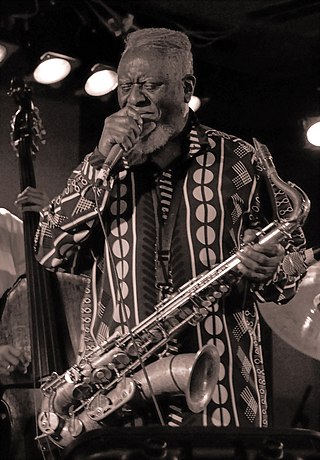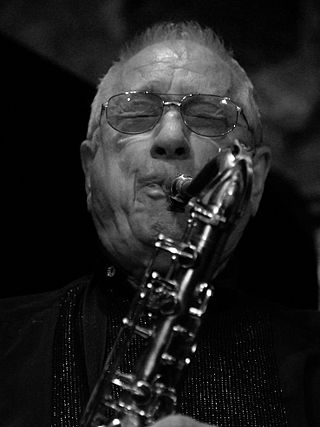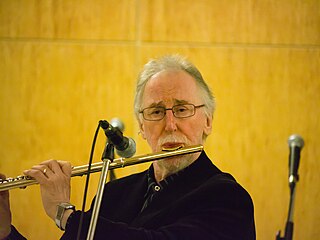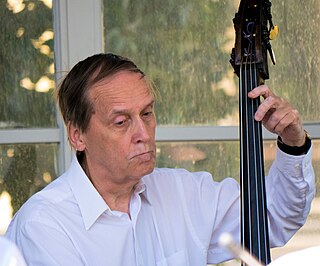
Pharoah Sanders was an American jazz saxophonist. Known for his overblowing, harmonic, and multiphonic techniques on the saxophone, as well as his use of "sheets of sound", Sanders played a prominent role in the development of free jazz and spiritual jazz through his work as a member of John Coltrane's groups in the mid-1960s, and later through his solo work. He released over thirty albums as a leader and collaborated extensively with vocalist Leon Thomas and pianist Alice Coltrane, among many others. Fellow saxophonist Ornette Coleman once described him as "probably the best tenor player in the world".

Howard Lewis Johnson was an American jazz musician, known mainly for his work on tuba and baritone saxophone, although he also played the bass clarinet, trumpet, and other reed instruments. He is known to have expanded the tuba’s known capacities in jazz.

Thaddeus Joseph Jones was an American jazz trumpeter, composer, and bandleader who has been called "one of the all-time greatest jazz trumpet soloists".
Blossom Toes were a British psychedelic pop band active between 1966 and 1970. Initially known as The Ingoes, they were renamed and signed to the Marmalade record label of manager Giorgio Gomelsky. The original line-up comprised Brian Godding, Jim Cregan, Brian Belshaw, and Kevin Westlake (born Kevin Patrick Westlake, 5 March 1947, Dublin, County Dublin, Ireland.
Blues Section are a Finnish rock music group. They started in 1967, formed around the vocalist Jim Pembroke, a British expatriate songwriter now living in Finland. The other members of the band were Eero Koivistoinen (saxophone), Ronnie Österberg (drums), Hasse Walli (guitar), and Måns Groundstroem (bass). Their influences came above all from John Mayall's Bluesbreakers and Jimi Hendrix, who had played a gig in Helsinki in May 1967. One can also hear in Pembroke's British-flavoured song-writing some echoes from The Beatles and The Kinks. Blues Section released a self-titled album late 1967 on Helsinki's Love Records. In 1968 Groundstroem and Pembroke left the band, being replaced by Pekka Sarmanto and Frank Robson, respectively. Also Koivistoinen would leave the band during the same year, and by the end of 1968 Blues Section was over. The Blues Section members would continue in such acclaimed progressive rock bands as Wigwam and Tasavallan Presidentti. Eero Koivistoinen was to become an internationally acclaimed jazz musician, and Hasse Walli would discover world music, playing in such bands as Piirpauke.

Hannes Mikael Waldemar "Hasse" Walli was born on 10 February 1948 in Helsinki. His father Aarno Walli was a musician and bandleader, his mother Anne-Marie Strandberg a singer. Hasse Walli was about ten years old when he started playing drums. He drummed in various bands in early 1960s such as The Islanders, The Electric Five and Nameless. Gradually Walli switched from drums to electric guitar. After Nameless had split, Walli started as a solo guitarist in The Typhoons. The Typhoons split when its members had to join the obligatory military service.

Pedro Iturralde Ochoa was a Spanish saxophonist, saxophone teacher and composer.

Jukka Jorma Tolonen is a Finnish jazz guitarist. Tolonen became famous as guitarist for the progressive rock band Tasavallan Presidentti.
Eero is an Estonian and Finnish masculine given name. Notable people with the name include:

Juhani Aaltonen is a Finnish jazz saxophonist and flautist.

Thad Jones, Mel Lewis and UMO is a big band jazz recording by UMO with guest bandleaders / performers Thad Jones and Mel Lewis. It was recorded in Helsinki in 1977 and was nominated for a 1979 Grammy award in the "Best Jazz Instrumental Performance - Big Band" category.

Pekka Eerik Juhani Sarmanto is a Finnish jazz bassist. Heikki Sarmanto is Pekka's brother.

Jarmo Savolainen was a Finnish jazz pianist and composer. He was born in Iisalmi, Eastern Finland, and first studied classical piano. He later turned his attention to jazz and studied at Berklee College of Music.
Ultima Thule primarily refers to:
Svart Records is a Finnish independent record company focused on heavy metal music, especially doom metal. It concentrates mostly on releasing LP reissues of albums previously unavailable on vinyl.

Pekka Juhani Pöyry was a Finnish jazz and rock saxophonist and flutist. He was part of the Pekka Pöyry Quartet and Quintet.
UMO Jazz Orchestra is a Finnish big band. It was founded in 1975 by jazz musicians Heikki Sarmanto and Esko Linnavalli.
Harry Kaj Olof Backlund was a Finnish jazz trumpeter, composer, arranger, bandleader, theorist, and one of the founders of the Helsinki Pop & Jazz Conservatory and the Jazz Department of Sibelius Academy. He was also one of the founding members of UMO Jazz Orchestra. He was a contemporary music education pioneer in Finland and a long-running senior music theory teacher in Helsinki Metropolia University of Applied Sciences.

Alexi Tuomarila is a Finnish jazz pianist and composer.
Kari Ikonen is a Finnish pianist, Moog player, and composer. He received the Yrjö-award from Jazz Finland in 2013, as the Finnish Jazz Musician of the Year.












